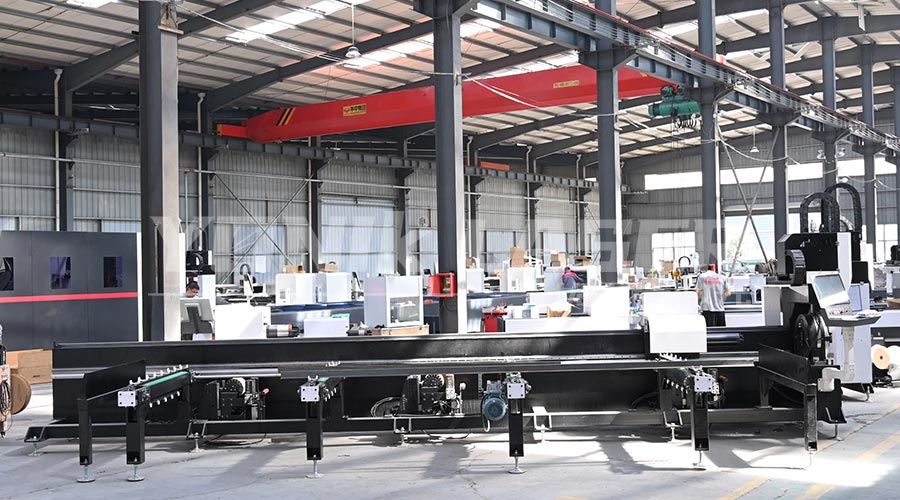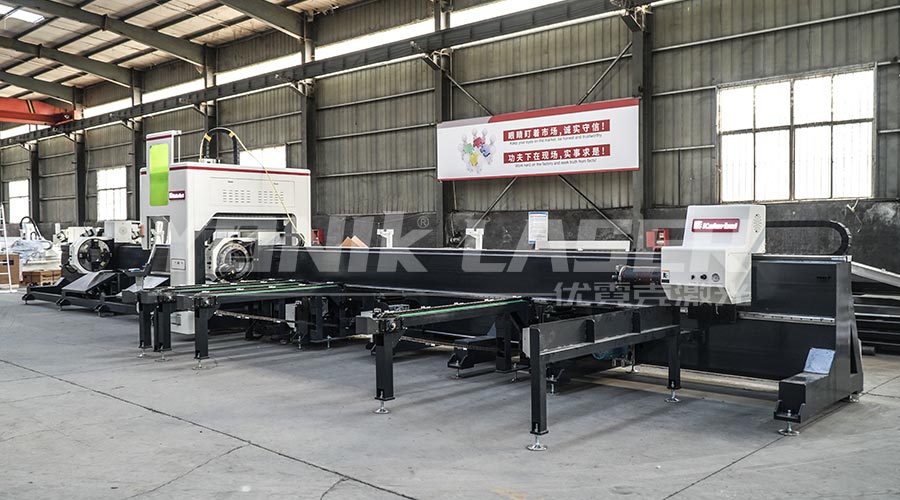In the wave of intelligent transformation in the manufacturing industry, laser cutting machines have become the core driving force for technological upgrading in the sheet metal processing industry. From automotive manufacturing to aerospace, from electronic devices to architectural decoration, laser cutting technology is redefining the production mode and industrial boundaries of sheet metal processing with its "cutting everything possible" attitude. This article will deeply analyze the innovative application scenarios of laser cutting machines in the sheet metal processing field and reveal how they promote the industry to move towards high-quality and high-value-added directions through technological iteration and mode innovation.

I. Technological Innovation: Core Breakthroughs from Single Processing to Intelligent Production
Traditional sheet metal processing relies on processes such as mechanical punching and flame cutting, which have pain points such as low precision, high material consumption, and complex processes. The technological upgrading of laser cutting machines has achieved a qualitative leap through beam quality optimization, control system upgrading, and material adaptability expansion.
1. Popularization of High-Power Fiber Lasers
Current mainstream laser cutting machines have fully adopted 10,000-watt-class fiber lasers, with cutting speeds 3-5 times faster than traditional equipment. For example, when cutting 10mm carbon steel plates, the speed can reach 4 meters per minute, while the heat-affected zone is reduced to within 0.5mm, effectively reducing workpiece deformation. An automotive parts manufacturer compressed the processing time of battery boxes from 180 seconds to 90 seconds by introducing a 12kW fiber laser cutting machine, and the material utilization rate was increased to 98%.
2. Evolution of Intelligent Control Systems
Based on artificial intelligence, the control system can realize dynamic optimization of the cutting path. By simulating the thermal deformation law during the cutting process, the system can automatically adjust the cutting sequence and parameters to reduce burrs and slag. After an enterprise applied an intelligent control system, the pass rate of stainless steel cutting increased from 85% to 97%, and the unit processing cost was reduced by 22%.
3. Multi-Axis Simultaneous Control and Composite Processes
The emergence of five-axis simultaneous control laser cutting machines has made complex curved surface processing possible. In the aerospace field, this technology can precisely cut titanium alloy skins, nickel-based alloy fuel tanks, and other components, with a processing accuracy of 0.05mm. Some equipment also integrates welding and marking functions to achieve one-stop production of "cutting-welding-marking".
II. Industry Applications: Scene Coverage from Standardization to Customization
The diversified needs of the sheet metal processing industry have spawned scenario-based innovations in laser cutting machines. The special requirements for precision, speed, and materials in different fields have promoted the customized development of technology.
1. Automotive Manufacturing: Dual Breakthroughs in Lightweight and Efficient Production
The rapid development of new energy vehicles has put forward higher requirements for sheet metal processing. Laser cutting machines can precisely process lightweight materials such as high-strength steel plates and aluminum alloys to meet the manufacturing needs of complex components such as battery boxes and motor housings. A new energy vehicle company reduced the processing steps of battery pack lower boxes from 7 to 3 by introducing a laser cutting machine, and the production cycle was shortened by 40%.
2. Aerospace: High-Precision Solutions for Difficult-to-Cut Materials
The cutting problem of difficult-to-cut materials such as titanium alloys and nickel-based alloys has been solved through ultra-fast laser technology and multi-axis simultaneous control systems. An aviation enterprise applied a picosecond laser cutting machine, and the surface roughness of aircraft skin cutting was reduced to Ra0.4μm, reaching aviation-grade standards, while the processing efficiency was increased by 3 times.
3. Electronic Equipment: Enabler of Micron-Level Precision Processing
In the 3C electronics field, laser cutting machines have achieved 0.1mm-level precision processing, which is suitable for micron-level cutting of thin plates such as mobile phone frames and server chassis. An electronics manufacturer improved the aperture accuracy of 5G base station heat sinks from ±0.1mm to ±0.02mm by introducing an ultra-fast laser cutting machine, with a product pass rate of 99.9%.
4. Architectural Decoration: Creative Realization of Personalized Customization
Laser cutting machines combined with digital design software can quickly convert personalized patterns into physical products. An architectural decoration enterprise realized batch customization of curtain wall hollowed-out patterns through laser cutting technology, and the design cycle of a single project was shortened from 15 days to 3 days, with customer satisfaction increased by 30%.
III. Industrial Synergy: Builder of Intelligent Manufacturing Ecosystem
The innovative application of laser cutting machines is promoting the evolution of sheet metal processing towards an "intelligent factory" model. Through seamless connection with industrial robots and AGV logistics systems, laser cutting units can be integrated into automated production lines to achieve unmanned operation of the entire process.
1. Core Node of Automated Production Lines
In an intelligent factory for automotive parts, laser cutting machines, six-axis robots, and AGV trolleys form a flexible production line. The plates are automatically fed from the stereoscopic warehouse, and after laser cutting, robot sorting, and AGV transportation to the welding station, no manual intervention is required throughout the process. This mode increased the single-line production capacity from 500 pieces/day to 1200 pieces/day, and labor costs were reduced by 70%.
2. Deep Integration of the Internet of Things and Big Data
By deploying an industrial internet platform, laser cutting machines can upload real-time operating data to the cloud. An enterprise optimized parameter settings after analyzing equipment energy consumption data and found that excessive auxiliary gas pressure led to energy waste when cutting stainless steel, saving 450,000 yuan in electricity costs annually.
3. Practice Model of Green Manufacturing
Laser cutting machines have significant energy-saving advantages. Compared with traditional plasma cutting, energy consumption is reduced by 70%, and no chemical cutting fluid is required. After an enterprise adopted a closed-loop cooling system, the energy conversion efficiency of the laser was increased to 40%, and annual carbon dioxide emissions were reduced by 120 tons.
IV. Future Trends: Bidirectional Driving of Technological Integration and Market Expansion
With the penetration of technologies such as 5G and industrial internet, laser cutting machines will evolve towards ultra-high-speed, ultra-precision, and ultra-flexible directions.
1. Application of Ultra-Short Pulse Laser Technology
The commercialization of picosecond and femtosecond lasers will achieve thermal-effect-free cutting of nanoscale materials. In the semiconductor field, this technology can precisely cut ceramic substrates, sapphire wafers, and other brittle materials, with a processing accuracy of micron level.
2. Composite Process of 3D Printing and Laser Cutting
The integration of additive manufacturing and subtractive manufacturing will break the dimensional limitations of traditional processing. A research institution developed a laser metal deposition-cutting composite equipment, which can first 3D print complex structures and then finish the surface through laser cutting, shortening the part manufacturing cycle by 50%.
3. Surge in Demand in Emerging Markets
The rapid development of fields such as medical equipment, rail transit, and new energy equipment has provided a broad space for laser cutting technology. According to forecasts, by 2026, the global laser cutting equipment market size will exceed 25 billion US dollars, of which the sheet metal processing field will account for more than 65%.

The innovative application of laser cutting machines in the sheet metal processing industry is not only an iteration of technical tools but also a revolution in production methods. From standalone operations to intelligent production lines, from mass production to personalized customization, from energy-consuming equipment to green benchmarks, laser cutting technology is leading the manufacturing industry towards a new stage of high-quality development with its "cutting everything possible" attitude. For sheet metal processing enterprises, embracing the innovation wave of laser cutting technology is not only an inevitable choice to enhance competitiveness but also a strategic opportunity to participate in the global industrial chain restructuring. In the future, with the deep integration of artificial intelligence and industrial scenarios, laser cutting machines will continue to write innovative legends in the sheet metal processing industry.
2025-07-22
2025-07-21
2025-07-19